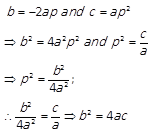GENERAL APTITUDE - Online Test
Q1. For section in an interview, anyone can be selected only after fulfilling all of the following criteria.
The person should have age between 21 and 30 years as on 01.03.2017. The person should have obtained at least 60% marks in class 12 and graduation degree both. The person should have a work experience of at least a year. The person should have got 70% marks in written test and 90% in language proficiency.
Sahil fulfills all the following criteria, then which of the following criterion/criteria will not lead to his final selection?
(i) He was born on 21.02.1996.
(ii) He completed his graduation in 2016 with 62% marks and 67% marks in class 12.
(iii) He has worked for 2 years in ABC Company.
(iv) He got 72% in written test and 95% in language proficiency.
The person should have age between 21 and 30 years as on 01.03.2017. The person should have obtained at least 60% marks in class 12 and graduation degree both. The person should have a work experience of at least a year. The person should have got 70% marks in written test and 90% in language proficiency.
Sahil fulfills all the following criteria, then which of the following criterion/criteria will not lead to his final selection?
(i) He was born on 21.02.1996.
(ii) He completed his graduation in 2016 with 62% marks and 67% marks in class 12.
(iii) He has worked for 2 years in ABC Company.
(iv) He got 72% in written test and 95% in language proficiency.
Answer : Option D
Explaination / Solution:
He was born on 21.02.1996 so on 01.03.2017, his age is 21 years, but the age should be between 21 and 30 means 22 to 29.
Q2. Directions: In the following questions two equations numbered I and II are given. You have to solve both the equations.
I. 5x2- 24x +16 = 0
II. 5y2 + 29y + 20 = 0
I. 5x2- 24x +16 = 0
II. 5y2 + 29y + 20 = 0
Answer : Option A
Explaination / Solution:
I. 5x2- 24x +16 = 0
x = 4/5, 4
II. 5y2 + 29y + 20 = 0
y = (-4/5, -5)
So X>Y
Q3. Running at the same constant rate, 6 identical machines can produce a total of 270 bottles per minute. At this rate, how many bottles could 10 such machines produce in 4 minutes?
Answer : Option B
Explaination / Solution:
Let the required number of bottles be x.
More machines, More bottles (Direct Proportion)
More minutes, More bottles (Direct Proportion)
| Machines | 6 | : | 10 |  | :: 270 : x |
| Time (in minutes) | 1 | : | 4 |
 6 x 1 x x = 10 x 4 x 270
6 x 1 x x = 10 x 4 x 270
 x = x = | (10 x 4 x 270) |
| (6) |
 x = 1800.
x = 1800.
Q4. 

Answer : Option B
Explaination / Solution:
No Explaination.
Q5. If  , then the relation among a, b, c would be
, then the relation among a, b, c would be
Answer : Option C
Explaination / Solution:



Comparing the corresponding coefficients,

Q6. Direction: Go through the charts below and answer the questions based on it.


The bar-charts shown here represent the earning of Ashok Manufacturing Company Private Limited, a manufacturing company located in Delhi.
Bar chart (1) gives us the details of company earnings (In crores) in the four quarters of the year across the five countries – India, Pakistan, Nepal, China and Bangladesh.
Bar chart (2) gives the details of its total earning (In crores) in the four quarters in years 2014, 2015 and 2016.
Bar chart (1) is applicable for bar chart (2) and vice-versa.
Bar Chart (1)


What is the difference between company’s earnings from Bangladesh during 2015 and earning from China during 2015?
Answer : Option D
Explaination / Solution:
Company’s earnings from Bangladesh during 2015 = 0.1 × 10 +0.25 × 20 + 0.3 × 15 = 10.5
Company’s earnings from China during 2015 = 0.15 × 20 + 0.4 × 10 + 0.1 × 20 + 0.2 × 15 = 12
Required Difference = 12 – 10.5 = 1.5 crore
Q7.
Principle: There are certain acts which, though harmful, are not wrongful in law; therefore, do not give legal right to bring action in law, to the person who suffers from such acts.
Facts: 'Prakash' has a rice mill. His neighbour, Shanti, sets up another rice mill and offers a tough competition to Prakash. As a consequence, Prakash's profits fall down. He brings a suit against Shanti for damages.
Answer : Option B
Explaination / Solution:
No Explaination.
Q8. Direction: What should come in place of question mark (?) in the following number series?
12, 6, 6, 9, 18, 45, ?
Answer : Option B
Explaination / Solution:
Series Pattern is ---> *.5,*1,*1.5,*2,*2.5,
So missing series = 45* 3 = 135
Q9. The smallest 3 digit prime number is:
Answer : Option A
Explaination / Solution:
The smallest 3-digit number is 100, which is divisible by 2.
 100 is not a prime number.
100 is not a prime number.
√101 < 11 and 101 is not divisible by any of the prime numbers 2, 3, 5, 7, 11.
 101 is a prime number.
101 is a prime number.
Hence 101 is the smallest 3-digit prime number.
Q10. 
Study the table carefully to answer the questions that follow.
Number of trees planted (in hundreds) by five different NGOs in six different years in two different states

What was the average number of trees planted by NGO-B in the state-A over all the years together?
Answer : Option A
Explaination / Solution:
Number of trees planted by NGO-B in the state-A over all the years = 6030
Required average
= (1420+790+770+1040+1260+750)/6
= 6030/6
= 1005
